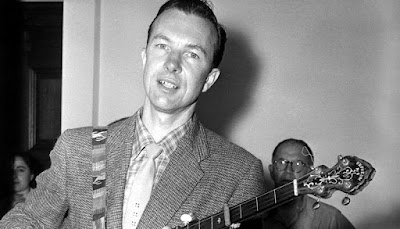Roots of the Revival: American and British Folk Music in the 1950s
Ronald D. Cohen and Rachel Clare Donaldson. University Of Illinois Press
(ISBN 978-0-252-08012-8)
Never as widely celebrated in folk circles as the decade that followed it, the 1950s nonetheless saw a fascinating period of transformation in the burgeoning revival on both sides of the Atlantic, with an unprecedented level of exchange between the US and the UK.
The primary motivation for many American performers to decamp to Europe was the great “red scare,” which led to the House Committee on Un-American Activities “witch hunt,” of progressive sympathisers and fellow-travellers. For some, like the blacklisted Pete Seeger, it was a case of continuing to work and perform, while for others, it was merely expedient to escape the heat for a while.
 |
| Pete Seeger |
Alan Lomax emerges as the central figure of the intertwined revivals in this decade. Ewan MacColl’s enthusiasm for folk music was inspired by Lomax’s 1950 field recording trip to Britain and Ireland and six years later MacColl would meet, and later marry, Peggy Seeger (who graces this book’s cover) when she came to transcribe Lomax’s work. Lomax would himself become involved in a transatlantic relationship by the decade’s end, with his assistant, Shirley Collins.
The impact of the Weavers is explored in some depth, as is the (now) oft-overlooked calypso phenomenon, which inspired teen magazine headlines like: “Elvis vs. Belafonte: The Big Battle of 1957 - Rock ’n’ Roll vs. Calypso! and a slew of movies like (the dreadful, but irresistibly titled) Bop Girl Goes Calypso!
The authors successfully maintain the reader’s interest through the inclusion of first-hand anecdotes and correspondence among the chronology, including this (sadly unrealised) proposal in a letter from Alan Lomax to Johnny Cash - “I have an enormous backlog of American folksongs which I think would be of great use to you in your further work as an American folk bard… It would be a great pleasure for me to work with you on developing this material for the commercial market.”
Roots Of The Revival does run out of steam a bit towards the end, but so did the 1950s. The decade’s closing year saw the surprise introduction of a young singer called Joan Baez at the inaugural Newport Folk Festival, providing America (and soon, Britain) with it’s first whiff of whatever it was that was blowin’ in the wind.
http://www.press.uillinois.edu




No comments:
Post a Comment